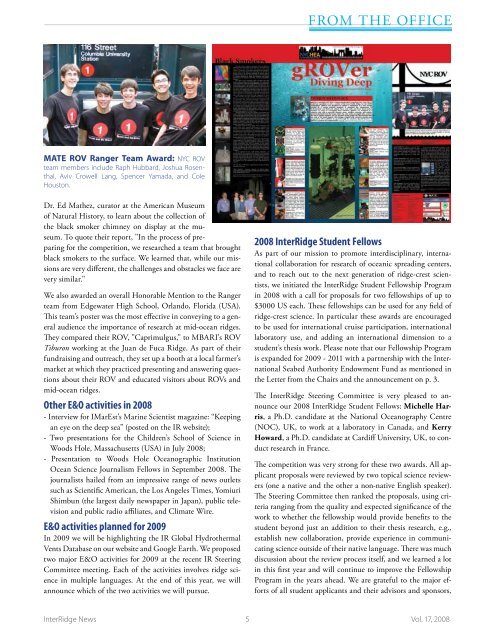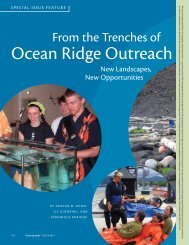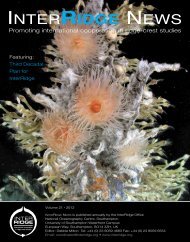Full version, lower resolution, 3.25MB - InterRidge
Full version, lower resolution, 3.25MB - InterRidge
Full version, lower resolution, 3.25MB - InterRidge
Create successful ePaper yourself
Turn your PDF publications into a flip-book with our unique Google optimized e-Paper software.
from the office<br />
MATE ROV Ranger Team Award: NYC ROV<br />
team members include Raph Hubbard, Joshua Rosenthal,<br />
Aviv Crowell Lang, Spencer Yamada, and Cole<br />
Houston.<br />
Dr. Ed Mathez, curator at the American Museum<br />
of Natural History, to learn about the collection of<br />
the black smoker chimney on display at the museum.<br />
To quote their report, "In the process of preparing<br />
for the competition, we researched a team that brought<br />
black smokers to the surface. We learned that, while our missions<br />
are very different, the challenges and obstacles we face are<br />
very similar."<br />
We also awarded an overall Honorable Mention to the Ranger<br />
team from Edgewater High School, Orlando, Florida (USA).<br />
This team's poster was the most effective in conveying to a general<br />
audience the importance of research at mid-ocean ridges.<br />
They compared their ROV, "Caprimulgus," to MBARI's ROV<br />
Tiburon working at the Juan de Fuca Ridge. As part of their<br />
fundraising and outreach, they set up a booth at a local farmer's<br />
market at which they practiced presenting and answering questions<br />
about their ROV and educated visitors about ROVs and<br />
mid-ocean ridges.<br />
Other E&O activities in 2008<br />
- Interview for IMarEst’s Marine Scientist magazine: “Keeping<br />
an eye on the deep sea” (posted on the IR website);<br />
- Two presentations for the Children’s School of Science in<br />
Woods Hole, Massachusetts (USA) in July 2008;<br />
- Presentation to Woods Hole Oceanographic Institution<br />
Ocean Science Journalism Fellows in September 2008. The<br />
journalists hailed from an impressive range of news outlets<br />
such as Scientific American, the Los Angeles Times, Yomiuri<br />
Shimbun (the largest daily newspaper in Japan), public television<br />
and public radio affiliates, and Climate Wire.<br />
E&O activities planned for 2009<br />
In 2009 we will be highlighting the IR Global Hydrothermal<br />
Vents Database on our website and Google Earth. We proposed<br />
two major E&O activities for 2009 at the recent IR Steering<br />
Committee meeting. Each of the activities involves ridge science<br />
in multiple languages. At the end of this year, we will<br />
announce which of the two activities we will pursue.<br />
2008 <strong>InterRidge</strong> Student Fellows<br />
As part of our mission to promote interdisciplinary, international<br />
collaboration for research of oceanic spreading centers,<br />
and to reach out to the next generation of ridge-crest scientists,<br />
we initiated the <strong>InterRidge</strong> Student Fellowship Program<br />
in 2008 with a call for proposals for two fellowships of up to<br />
$3000 US each. These fellowships can be used for any field of<br />
ridge-crest science. In particular these awards are encouraged<br />
to be used for international cruise participation, international<br />
laboratory use, and adding an international dimension to a<br />
student’s thesis work. Please note that our Fellowship Program<br />
is expanded for 2009 - 2011 with a partnership with the International<br />
Seabed Authority Endowment Fund as mentioned in<br />
the Letter from the Chairs and the announcement on p. 3.<br />
The <strong>InterRidge</strong> Steering Committee is very pleased to announce<br />
our 2008 <strong>InterRidge</strong> Student Fellows: Michelle Harris,<br />
a Ph.D. candidate at the National Oceanography Centre<br />
(NOC), UK, to work at a laboratory in Canada, and Kerry<br />
Howard, a Ph.D. candidate at Cardiff University, UK, to conduct<br />
research in France.<br />
The competition was very strong for these two awards. All applicant<br />
proposals were reviewed by two topical science reviewers<br />
(one a native and the other a non-native English speaker).<br />
The Steering Committee then ranked the proposals, using criteria<br />
ranging from the quality and expected significance of the<br />
work to whether the fellowship would provide benefits to the<br />
student beyond just an addition to their thesis research, e.g.,<br />
establish new collaboration, provide experience in communicating<br />
science outside of their native language. There was much<br />
discussion about the review process itself, and we learned a lot<br />
in this first year and will continue to improve the Fellowship<br />
Program in the years ahead. We are grateful to the major efforts<br />
of all student applicants and their advisors and sponsors,<br />
<strong>InterRidge</strong> News 5 Vol. 17, 2008
















